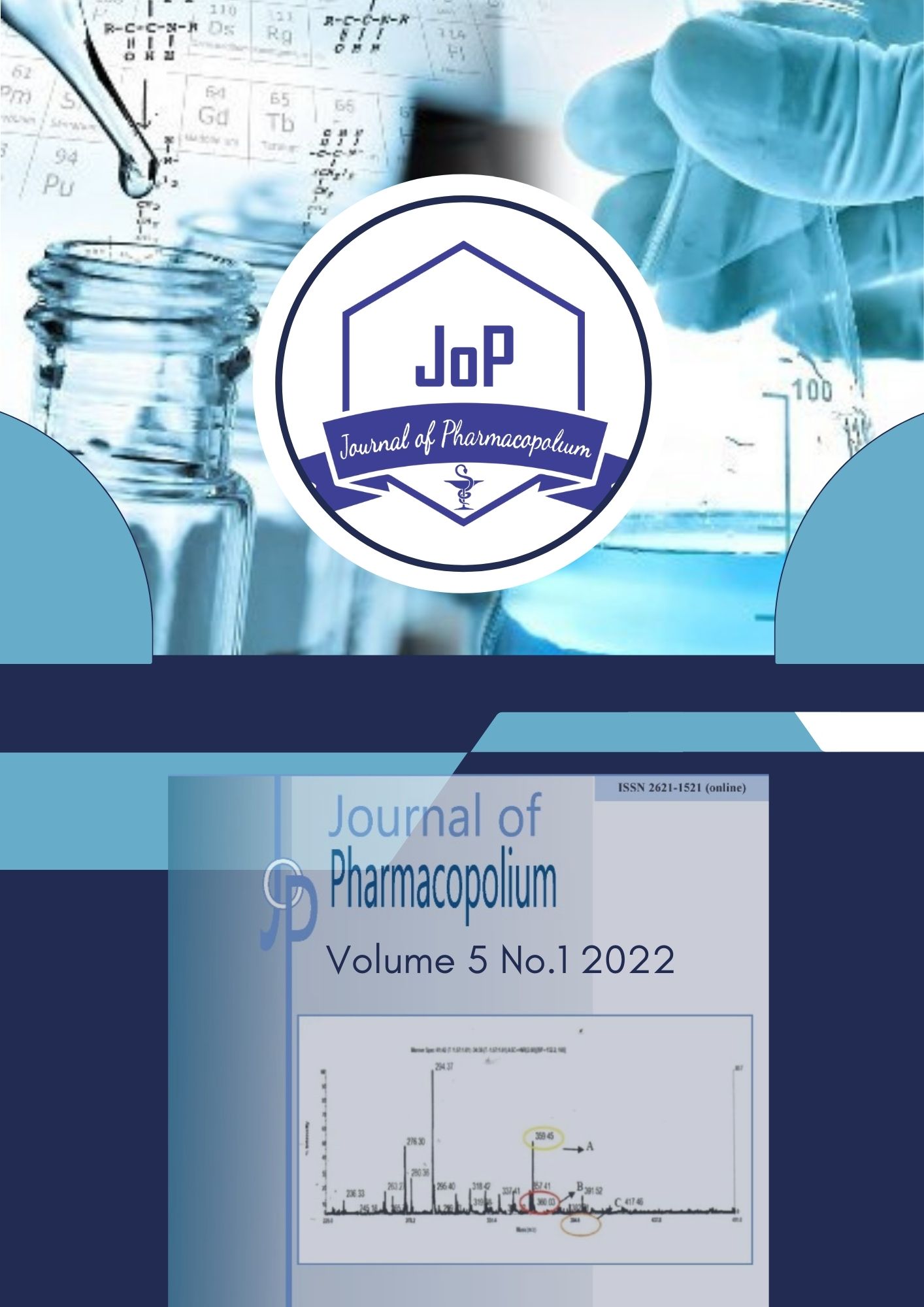PREDIKSI BIOAVAILABILITAS DAN INTERAKSI SENYAWA METABOLIT SEKUNDER BUAH PLUM (Prunus domestica) TERHADAP HMG-CoA REDUKTASE SECARA IN SILICO
DOI:
https://doi.org/10.36465/jop.v5i1.875Keywords:
HMG-CoA reductase, hyperlipidemia, in silico, plum fruit, Prunus domesticaAbstract
Hyperlipidemia is a condition in which one or more lipid profiles in the blood have increased. Plum fruit (Prunus domestica) was empirically used to treat hyperlipidemia by reducing the production of cholesterol in the blood. This study has the purpose to predict the bioavailability and interaction of the secondary metabolites of P. domestica fruit against HMG-CoA reductase using in silico method. This study uses the SwissADME webserver with the Boiled-Egg method to predict bioavailability and PyRx0.8 to predict the interaction of compounds by molecular docking. From 108 secondary metabolites, 37 compounds were predicted to have good bioavailability. There were two compounds (cyaniding and tryptamine) that were predicted to have potential as anti hyperlipidemia similar to or better than antihyperlipidemic drugs of the statin class (simvastatin). Cyanidin and tryptamine have binding energy values (-5.12 kcal/mol and -4.95 kcal/mol) and estimated inhibition constant (117.15 µM and 234.67 µM) better than simvastatin (-4.96 kcal/mol and 231.44 µM). Both compounds also have similar amino acid residues interaction (Lys735 for cyanidin and Glu559 for tryptamine) with simvastatin.
References
Aurora, R. G., Sinambela, A., & Noviyanti, C. H. (2012). Artikel Pengembangan Pendidikan Keprofesian Berkelanjutan (P2KB) Peran Konseling Berkelanjutan pada Penanganan Pasien Hiperkolesterolemia. Journal of Indonesian Medical Association, 62(5), 194–201.
Basuny, A. M. M., Arafat, S. M., & El-marzooq, M. A. (2012). Antioxidant and Antihyperlipidemic activities of anthocyanins from eggplant peels. Journal of Pharma Research and Reviews, 2(3), 50–57.
Chait, A., & Brunzell, J. D. (1990). Acquired Hyperlipidemia (Secondary Dyslipoproteinemias). Endocrinology and Metabolism Clinics of North America, 19(2), 259–278.
Daina, A., & Zoete, V. (2016). A BOILED-Egg To Predict Gastrointestinal Absorption and Brain Penetration of Small Molecules. ChemMedChem, 1117–1121. https://doi.org/10.1002/cmdc.201600182
Debata, J., & Kumar, H. K. S. (2019). Assessment of antihyperglycemic and antihyperlipidemic activity of Acacia suma ROXB ROOT. Pharmacophore, 10(2), 1–6.
Du, C., Shi, Y., Ren, Y., Wu, H., Yao, F., Wei, J., Wu, M., Hou, Y., & Duan, H. (2015). Anthocyanins inhibit high-glucose-induced cholesterol accumulation and inflammation by activating LXRα pathway in HK-2 cells. Drug Design, Development and Therapy, 9, 5099–5113. https://doi.org/10.2147/DDDT.S90201
Hahn, H. J., Abagyan, R., Podust, L. M., Roy, S., Ali, I. K. M., & Debnath, A. (2020). HMG-CoA reductase inhibitors as drug leads against Naegleria fowleri. ACS Chemical Neuroscience, 11(19), 3089–3096. https://doi.org/10.1021/acschemneuro.0c00428
Isnaniar, Norlita, W., & Wiradinata, D. I. (2020). Pengaruh Terapi Bekam Terhadap Kadar Kolesterol Pasien Hiperkolesterolemia Di Thibbun Nabawi Centre RSIA Zainab Pekanbaru Tahun 2019. Photon: Jurnal Sain Dan Kesehatan, 10(2), 125–136. https://doi.org/10.37859/jp.v10i2.1869
Istvan, E. S., & Deisenhofer, J. (2001). Structural mechanism for statin inhibition of HMG-CoA reductase. Science, 292(5519), 1160–1164. https://doi.org/10.1126/science.1059344.
Kim, R., & Skolnick, J. (2012). Software News and Updates Gabedit — A Graphical User Interface for Computational Chemistry Softwares. Journal of Computational Chemistry, 29(8), 1317–1331. https://doi.org/10.1002/jcc
Ma’arif, B., Mirza, D. M., Suryadinata, A., Muchlisin, M. A., & Agil, M. (2019). Metabolite Profiling of 96% Ethanol Extract from Marsilea crenata Presl. Leaves Using UPLC-QToF-MS/MS and Anti-Neuroinflammatory Predicition Activity with Molecular Docking Burhan. Journal of Tropical Pharmacy and Chemistry, 4(6), 261–270.
Nandini, H. S., & Naik, P. R. (2019). Antidiabetic, antihyperlipidemic and antioxidant effect of Vincamine, in streptozotocin-induced diabetic rats. European Journal of Pharmacology, 843, 233–239. https://doi.org/10.1016/j.ejphar.2018.11.034
Sagay, S. J. J., Simbala, H. E. I., & De Queljoe, E. (2019). Uji aktivitas antihiperlipidemia ekstrak etanol buah pinang yaki (Areca vestiaria) pada tikus putih galur wistar(Rattus norvegicus) yang diinduksi pakan hiperlipidemia. Pharmacon, 8(2), 442–448. https://doi.org/10.35799/pha.8.2019.29314
Saidi, M. R., Farzaei, M. H., Miraghaee, S., Babaei, A., Mohammadi, B., Bahrami, M. T., & Bahrami, G. (2016). Antihyperlipidemic Effect of Syrian Mesquite (Prosopis farcta) Root in High Cholesterol Diet–Fed Rabbits. Journal of Evidence-Based Complementary and Alternative Medicine, 21(4), NP62–NP66. https://doi.org/10.1177/2156587215627552
Siddiqui, R. A. (2017). Plums as Potential Dietary Agents to Prevent Obesity and Obesity-Related Disorders. Journal of Obesity & Therapeutics, 1(1).
Syahputra, G., Ambarsari L, & T, S. (2014). Simulasi docking kurkumin enol, bisdemetoksikurkumin dan analognya sebagai inhibitor enzim12-lipoksigenase. Biofisika, 10(1), 55–67.
U.S. Department of Agriculture Agricultural Research Service. (n.d.). Dr. Duke’s Phytochemical and Ethnobotanical Databases. https://doi.org/10.15482/USDA.ADC/1239279








